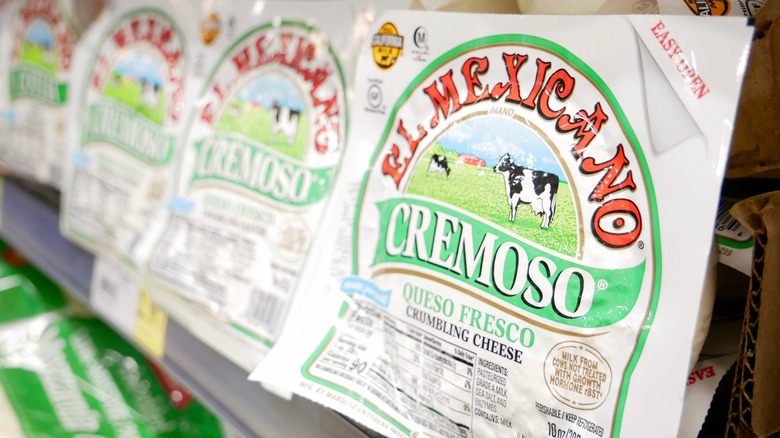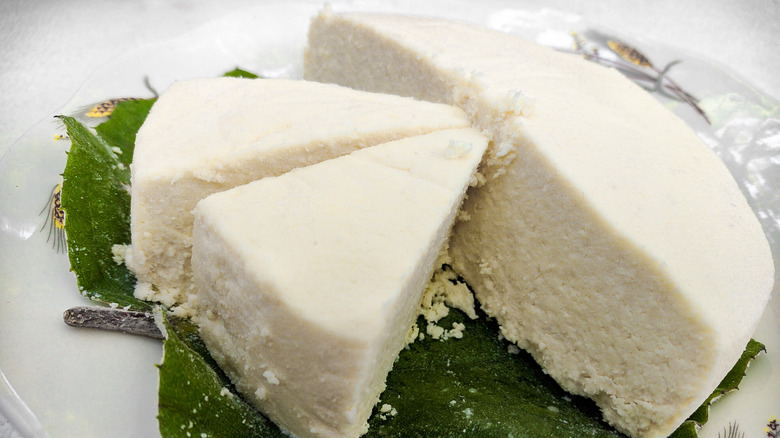Here's How Long Queso Fresco Is Good For After Opening
Whether you're sprinkling a palmful over a hearty batch of verde enchiladas or adding a touch of tangy richness to a bowl of chicken tortilla soup, crumbly queso fresco has many uses. But like all dairy products, it doesn't last forever. Though it may be tempting to reach for that delicious wheel of cheese beyond its expiration date, it's important to consume queso fresco before it goes bad to avoid eating ill-tasting cheese and contracting foodborne illness.
Dry, crumbly cheeses typically last longer than their fresh counterparts. But don't confuse queso fresco with cotija, a hard Mexican cheese with a similar appearance. Queso fresco is a fresh, moist cheese with a soft texture that, like other cheeses that share its characteristics, lasts up to seven days after opening its package. Water is a breeding ground for food-loving bacteria and pathogens, and because queso fresco is a high-moisture cheese, it's particularly dangerous to consume beyond its expiry.
Proper queso fresco storage
Queso fresco is a delicious, versatile, and affordable cheese that deserves a spot in your refrigerator's cheese drawer. Although it only lasts seven days after opening, you can maximize your enjoyment by adhering to proper queso fresco storage practices.
Always transfer leftover queso fresco from its original packaging to an air-tight container such as lidded food storage containers, mason jars, and sealable plastic bags. This protects the cheese from exposure to open air — an element that expedites spoilage. Store the container in a refrigerator set to at least 40 degrees Farenheit to maintain the freshness and taste of queso fresco. Never let the cheese sit at room temperature for more than two hours, as beyond that time frame, it's not safe to consume. If you're featuring queso fresco as a Tex-Mex topping on taco Tuesday, consider serving it on an ice tray to keep it cool.
You can also freeze queso fresco to extend its shelf life, but it's possible that freezing can disrupt the taste and texture of the cheese. If you do freeze leftover queso fresco, wrap it in foil before transferring it to a container to avoid freezer burn. Frozen queso fresco is best enjoyed within two months and should be thawed overnight in the refrigerator before consumption.
Signs of queso fresco spoilage
Memorizing the signs of spoiled queso fresco is an essential food safety practice. Just because you've monitored how long it's been opened and you've done your part to ensure proper storage, it's still important to trust your senses.
First, perform an eye test. If you notice mold on the wheel of cheese, trash it. Moldy queso fresco can harbor illness-causing bacteria such as Listeria, E.coli, and Salmonella, so it's important to immediately discard of the cheese in the presence of fuzz. If mold makes its way onto the storage container, remove it immediately without making direct skin contact before soaking it in a bleach-water solution for at least 30 minutes. Similarly, noticeable discoloration, slime, or excessive dryness are also signs of spoilage. Queso fresco has a fresh, light scent, so use your nose to suss out any conspicuous fragrance. If you smell sour, ripe aromas akin to spoiled milk, that's a surefire sign it's time to part ways with your queso fresco wheel and purchase a new one.
Queso fresco is a tasty, useful ingredient. As long you long as store it correctly and consume it within seven days after opening, you will get the most of out this milky, fresh, and adaptable cheese. Remember — safe eating is happy eating!


